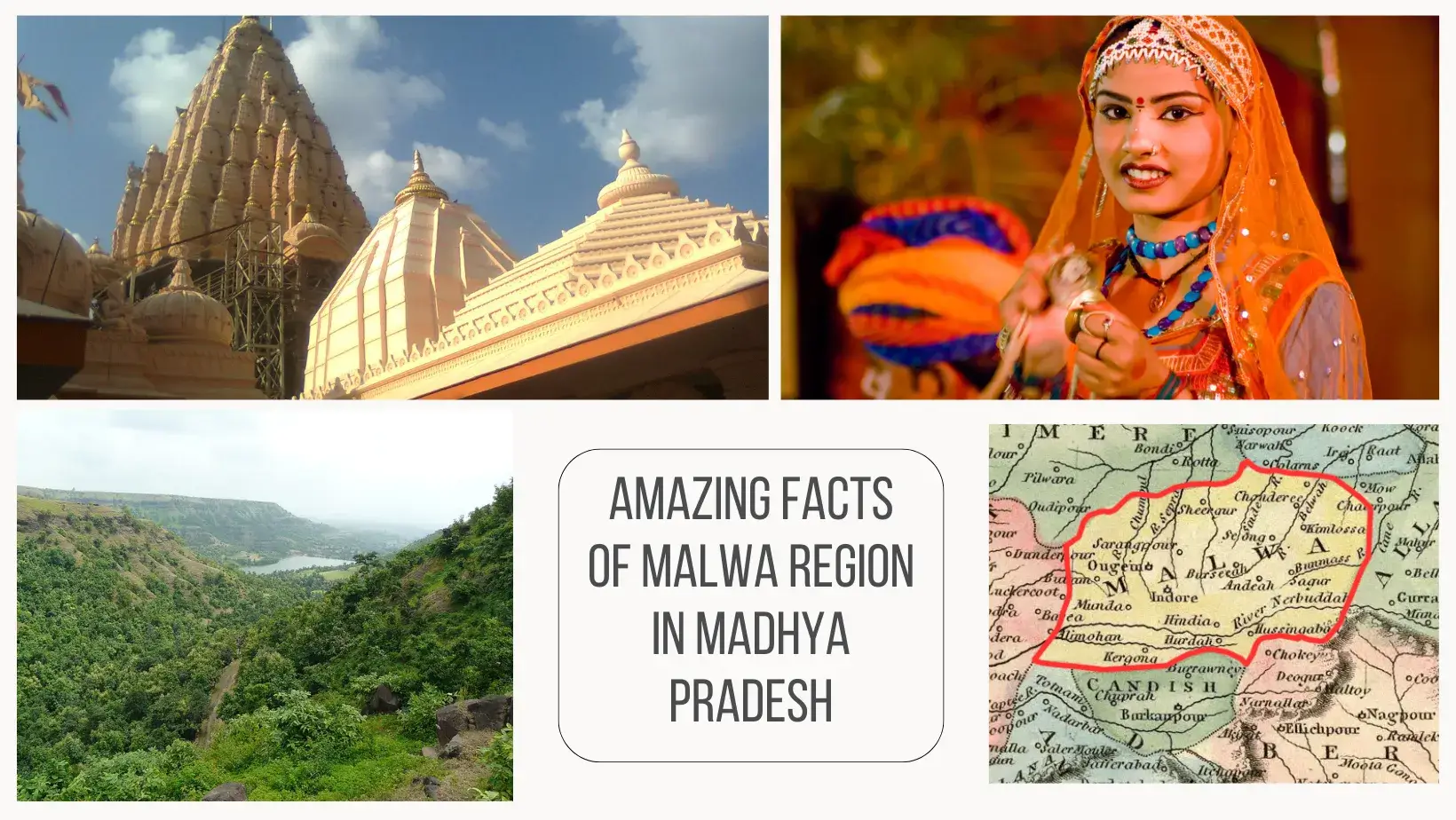Malwa is a geographical area situated in the north-central region of India, known as the Malwa Plateau in India. It is primarily a part of Madhya Pradesh, extending to its eastern boundaries. The region is home to several major cities and spiritual destinations, including Indore, Omkareshwar, Maheshwar, and Ujjain, each known for its cultural and historical significance. The Malwa Plateau in India has a rich political history, having been ruled by the Maratha Holkars. The region experienced prosperity under the administration of Devi Ahilyabai Holkar, who is celebrated for her progressive and effective governance.
In this blog, we will revisit the importance of Madhya Pradesh, focusing on the unique political and geographical aspects of the Malwa Plateau in India. We will delve into its historical background, exploring the factors that have shaped its development over the centuries. Additionally, we will highlight the natural beauty of the Malwa Plateau, from its fertile lands to its diverse flora and fauna, which continue to enrich the lives of the people in Madhya Pradesh. Join us as we explore the history, culture, and natural gifts that make the Malwa Plateau in India a remarkable region.
Geographical Location of Malwa Plateau


The Malwa Plateau, located in the north-central region of India, is volcanic in origin and extends from central Madhya Pradesh to southeastern Rajasthan. This plateau generally forms a triangular shape, with its center on the Vindhya Hills. It is bordered by the Aravali Ranges to the west, the Madhya Bharat Pathar to the north, and the Bundelkhand region to the east. 1
The Malwa Plateau, located strategically between these regions, is known for its fertile soil and diverse topography, which have played a significant role in shaping the culture and economy of the surrounding areas.
Topography and Physical Features of the Malwa Plateau


The Malwa region in India features a variety of soil types, including black, brown, and bhatori (stony). The black soil reflects the region’s volcanic geological history, while the brown, clay-like soil is due to the high iron concentration in the basalt from which it is formed. These soils have excellent water retention capacity, reducing the need for frequent watering, and making them ideal for agriculture. The plateau has an average elevation of 500 meters, with Sigar being the highest point at 881 meters, followed by Janapav at 854 meters, and Ghajari at 810 meters.
Agriculture is the primary occupation in the Malwa region in India, known historically for producing opium. Other crops grown here include jowar, rice, wheat, coarse millet, peanuts, pulses, soybeans, cotton, linseed, sesame, and sugarcane. 2
The region is also defined by four major river systems: the Mahi, Ken-Betwa, and Chambal. The Shipra River holds significant cultural and religious importance due to the Simhastha Mela, a major festival that takes place every 12 years. These geographical features and natural resources have greatly influenced the agricultural practices and cultural traditions of the Malwa region in India.
Cultural and Historical Significance of the Malwa Region


The Malwa region in India is renowned for its rich cultural heritage, prominently marked by the Chalcolithic culture. This culture was first identified during excavations at Maheshwar, located along the Narmada River. The present city of Maheshwar is believed to be the ancient city of Mahishmati, as mentioned in the Puranas. Alongside the Chalcolithic culture, the Malwa region also hosted other cultures, such as those found at Nagda, Kayatha, and Eran. The cultural history of this region is thought to have begun between 1900-1400 BC.3
Numerous ancient settlements were discovered along the banks of the Narmada‘s tributaries. These settlements were strategically built using a two-level settlement pattern, which protected them from floods. Notable settlements include Navdatoli, Nagda, and Eran, with Navdatoli being the largest among them.
The Malwa region in India is also known for its traditional vegetarian cuisine. Some of the famous dishes include Bhutte Ka Kees, Chakki ri Shaak, Dal Baati, Amli ri Kadhi, Thulli, Shrikhand, Malpua, and Mawa Bati.4
The region is vibrant with cultural and traditional festivals, such as:
- Malwa Utsav Indore: This is the largest festival in Indore, celebrating art, music, dance, drama, and culture. Performers from around the world participate in this event, which takes place during the first week of May.5
- Chaitra Fair: Held on the tenth day of the Bhadra month to mark the birth of Tejaji, this fair takes place in Biaora and over two dozen villages in Malwa. Similar fairs are also held in Ujjain, Mandhata, and nearby regions.
- Triveni Mela: This fair occurs in Ratlam during the Kartika month, with similar events also taking place in Ujjain, Mandhata (Nimad), and other areas.
The Malwa region is also famous for its traditional handloom products. Two of the most popular are Chanderi and Maheshwari sarees. Chanderi sarees are made from pure silk or cotton, featuring intricate patterns of peacocks, motifs, and geometric designs. Maheshwari sarees, on the other hand, are made from cotton and often feature stripes and checks, showcasing the region’s unique weaving techniques.
Economic and Agricultural Importance of the Malwa Plateau
The Malwa region, located on the Malwa Plateau, is rich in agricultural and economic activity. This region is a major hub for opium production, making it one of the largest opium-growing areas in the world. The fertile brown soil found in the Malwa region is ideal for cultivating annual crops such as wheat, gram, and sesame (til). Additionally, the principal crops grown here include jowar, rice, coarse millet, peanuts, pulses, soybeans, cotton, linseed, and sugarcane.
The black volcanic soil of the Malwa Plateau, which is rich in iron due to its basaltic origin, is particularly suitable for cotton cultivation. These diverse soil types and favorable climatic conditions make the Malwa region a vital contributor to India’s agricultural output.6
Tourism in the Malwa Plateau


The Malwa region, located on the Malwa Plateau in Madhya Pradesh, offers numerous tourist attractions that showcase its rich history and cultural heritage.7
- Mandu: Once the fort capital of the Parmar Dynasty, Mandu is home to the impressive Mandu Fort. Visitors can explore other landmarks such as Jahaz Mahal, Hindola Mahal, Roopmati Mahal, Hoshang Shah’s Tomb, and Baz Bahadur’s Palace, which exhibit stunning architecture and Afghan influences.
- Bhimbetka: Known for its fascinating rock caves, the Bhimbetka rock shelters provide evidence of the earliest traces of human existence in India. Designated as a UNESCO World Heritage Site, these shelters near Bhopal feature prehistoric paintings on cave walls, some of which are around 30,000 years old.
- Ujjain: While Bhopal and Indore are major cities in the Malwa region, Ujjain is a city deeply rooted in tradition and culture. It is home to over 100 ancient temples that exhibit exquisite ancient Indian architecture. The Mahakal Temple, one of the 12 Jyotirlingas, is famous for its unique Bhasma Aarti. Ujjain also hosts the Simhastha Mela every 12 years, drawing pilgrims and tourists from around the world.
Conclusion
The Malwa Plateau, located in central India, is a region rich in history, culture, and natural beauty. Its unique location on the volcanic plateau contributes to its fertile soil and diverse landscapes, making it a significant area for agriculture and tourism. Exploring the Malwa region offers a chance to discover its rich heritage, from ancient forts and temples to vibrant cultural festivals. Understanding the Malwa Plateau is crucial for locals and tourists alike, as it provides insight into India’s historical and cultural evolution. Discover the Malwa Plateau and experience the diversity and richness that this remarkable region has to offer.
Reference:
- https://prepp.in/news/e-492-malwa-plateau-geography-notes ↩︎
- https://prepp.in/news/e-492-malwa-plateau-geography-notes ↩︎
- https://shaan.academy/kayatha-malwa-culture/ ↩︎
- https://www.nativeplanet.com/travel-guide/explore-the-rich-heritage-at-malwa-plateau-of-madhya-pradesh/articlecontent-pf19553-003924.html ↩︎
- https://utsav.gov.in/view-event/malwa-utsav ↩︎
- https://prepp.in/news/e-492-malwa-plateau-geography-notes ↩︎
- https://www.india.com/travel/articles/top-places-to-explore-in-madhya-pradeshs-malwa-region-3684656/ ↩︎

